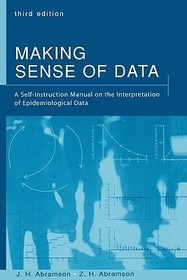
Making Sense of Data
A Self-Instruction Manual on the Interpretation of Epidemiological Data
- Publisher's listprice GBP 69.00
-
32 964 Ft (31 395 Ft + 5% VAT)
The price is estimated because at the time of ordering we do not know what conversion rates will apply to HUF / product currency when the book arrives. In case HUF is weaker, the price increases slightly, in case HUF is stronger, the price goes lower slightly.
- Discount 10% (cc. 3 296 Ft off)
- Discounted price 29 668 Ft (28 256 Ft + 5% VAT)
Subcribe now and take benefit of a favourable price.
Subscribe
32 964 Ft

Availability
printed on demand
Why don't you give exact delivery time?
Delivery time is estimated on our previous experiences. We give estimations only, because we order from outside Hungary, and the delivery time mainly depends on how quickly the publisher supplies the book. Faster or slower deliveries both happen, but we do our best to supply as quickly as possible.
Product details:
- Edition number 3
- Publisher OUP USA
- Date of Publication 1 November 2001
- ISBN 9780195145250
- Binding Paperback
- No. of pages384 pages
- Size 233x155x17 mm
- Weight 535 g
- Language English
- Illustrations numerous tables and figures 0
Categories
Short description:
This is a self-instructional manual on the interpretation and use of epidemiologic data that deals with the basic concepts and skills needed for appraising published reports or study findings. Applications in clinical medicine, public health, community medicine, and research are presented. The numerous changes in this edition include the addition of a section on questions to be asked before deciding to apply study results in practice, discussions of new topics (Cox proportional hazards regression, qualitative studies, ROC curves), and fresh examples.
MoreLong description:
This is a self-instructional manual on the interpretation and use of epidemiologic data that deals with the basic concepts and skills needed for appraising published reports or study findings. Applications in clinical medicine, public health, community medicine, and research are presented. The numerous changes in this edition include the addition of a section on questions to be asked before deciding to apply study results in practice, discussions of new topics (Cox proportional hazards regression, qualitative studies, ROC curves), and fresh examples.
MoreTable of Contents:
Introduction
The aim of the book
How to use the book
A. Basic Concepts and Procedures
Introduction
Determining what the facts are, Summarizing the facts
Absolute and relative differences
Diagrams
Seeking explanations for the facts, Testing explanations
The basic scientific process, Rates
Rates (continued), Inspecting a two-dimensional table
Inspecting a two-dimensional table (continued)
Inspecting a two-dimensional table (continued), Associations
Associations (continued), Confounding
Confounding (continued), Effect modification
Refinement, skeleton tables, Elaborating an association
Modifying and confounding effects
Elaborating an association (continued)
The use of rates, Causal explanations, Testing causal explanations
Testing causal explanations (continued, Basic procedure for appraisal of data, What are the facts? What are the possible explanations? What additional information is required?
Uses of epidemiological data
Test yourself (A)
B. Rates and Other Measures
Introduction, What is a rate? Prevalence rates
Prevalence rates (continued)
Questions about a rate, What kind of rate is it? Of what is it a rate? To what population or group does the rate refer? How was the information obtained?
Sources of bias, Confidence interval, Validity, Qualitative studies
Use of prevalence data, Incidence rates
Incidence rates (continued)
Bias in incidence studies
Uses of incidence rates
Estimating the individual's chances, Time to event (survival time)
Estimating the individual's chances (continued), Other rates, What are the odds?
Other rates (continued), Odds ratio
Other measures
Indirect standardization
Indirect standardization (continued), Direct standardization
The use of standardized rates
Test yourself (B)
C. How Good Are the Measures?
Introduction
Validity of a measure, Sensitivity and specificity
Misclassification
Differential misclassification
Effects of misclassification
Effects of misclassification (continued)
Other ways of appraising validity, Reliability
Appraisal of reliability
Appraisal of reliability (continued), Regression towards the mean, Taking account of validity and reliability, Screening tests
Appraisal of a screening test
Appraisal of a screening test (continued)
Appraisal of diagnostic tests, ROC curves, The meaning of "normal"
Test yourself (C)
D. Making Sense of Associations
Introduction
Explanations for an association
Effects of misclassification, Statistical significance
Statistical significance (continued)
Confounding effects
Confounding effects (continued)
Multivariate analysis
Explanations for the findings, Risk factors and risk markers, Appraising a risk marker, Uses of the findings
Risk factors and risk markers (continued), Measures of the strength of an association
Measures of strength
Measures of strength (continued), Matched samples
Synergism
Appraising stratified data, Making sense of multivariate analysis
Multiple logistic regression
Multiple logistic regression (continued)
Proportional hazards regression
Multiple linear regression
Test yourself (D)
E. Causes and Effects
Introduction, Kinds of Study
Appraising the results of a cross-sectional study
Appraising the results of a case-control study
Appraising the results of a cohort study
Appraising the results of a group-based study
Appraising the results of an experiment
Appraising the results of a quasi-experiment
Artifact, confounding or cause?
Coping with confounding, Delving into causes
Evidence for a causal relationship
Evidence for a causal relationship (continued), The impact of a causal factor
The attributable fraction
Prevented and preventable fractions
Test yourself (E)
F. Meta-Analysis: Putting It All Together
Introduction
The scope of meta-analysis
Measures used in meta-analysis
Measures used in meta-analysis (continued), Basic information
Finding the studies
Selecting studies
The quality of the studies, Extracting the findings, Apples and oranges
Appraising combinability, Explaining heterogeneity
Explaining heterogeneity (continued)
Effect modification
Using the results, Evaluating a meta-analysis
Test yourself (F)
G. Putting Study Findings to Use
Introduction
Are the results accurately known
Validity of the findings
Relevance of the findings
Expected effects
Feasibility and cost
Test yourself (G)
References
Index








